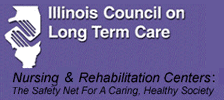|
FOR IMMEDIATE RELEASE
February 3, 2009
When Seconds
Count: Recognizing the Signs of a Stroke
Stroke is a serious, life-threatening emergency in which
every second counts for reducing damage to the brain. It
is the third leading cause of death in the United States
and a primary cause of long-term disability. About
600,000 new strokes occur in the United States each
year.
The Illinois Council on Long Term
Care, a state nursing home association, offers the
following crucial information about recognizing the
signs of a stroke, seeking immediate intervention and
avoiding strokes.
A stroke occurs when blood flow to
part of the brain is interrupted, which is why it is
often called a “brain attack.” There are two major kinds
of stroke:
- Ischemic stroke is caused by a
blood clot that blocks or plugs a blood vessel or
artery in the brain. About 80 percent of all strokes
are ischemic; and
- Hemorrhagic stroke occurs when a
blood vessel in the brain breaks and bleeds into the
brain. About 20 percent of all strokes are
hemorrhagic.
Stroke can affect the entire body
and lead to serious disability. The effects of a stroke
can include paralysis, vision impairment, problems with
thinking, problems with speaking, and emotional
difficulties. Many people may need intensive therapy and
rehabilitation after a stroke, and some have a hard time
living independently.
It’s not always easy to recognize
when someone is having a stroke. It might seem like the
person just seems a bit dizzy or confused. Be alert for
the following stroke symptoms:
The
National Stroke Association offers the following simple
test, called “Act F.A.S.T.,” for determining if someone
is having a stroke. The Council recommends that people
memorize the following guidelines:
Face
Ask the person to smile. Does one side of the face
droop?
Arms Ask the person to raise both arms. Does one arm drift
downward?
Speech
Ask the person to repeat a
simple sentence. Are the words slurred? Can he or she
repeat the
sentence correctly?
Time If the person shows any
of these symptoms, time is extremely important. Call 911
and get the
person to the hospital as soon as possible.
Every second counts when someone is
having a stroke. The longer blood flow is cut off to the
brain, the greater the damage. Immediate treatment can
save people’s lives and enhance their chances for a
successful recovery. Unfortunately, according to the
National Stroke Association, most people don’t go to the
emergency room until more than 24 hours after they
experience stroke symptoms.
Here are some important lifestyle
changes that can reduce your risk of stroke:
- Keep your blood
pressure under control. There are many medications
that can help you achieve this important goal. High
blood pressure is perhaps the biggest risk factor
for stroke.
- Don’t smoke.
Smoking can more than double your risk of having a
stroke. Avoid secondhand smoke too.
- Eat a
heart-healthy diet that includes plenty of fish,
fruits and vegetables, beans, high-fiber grains and
breads, and olive oil. Reduce your consumption of
salt.
- Talk to your
doctor about creating a safe and healthy exercise
program.
- Know your
cholesterol levels, and talk to your doctor about
the proper use of medications.
- Limit your
alcohol consumption. Having more than two drinks a
day increases your risk of stroke.
- Take a daily
aspirin or other medicines as advised by your
doctor.
- If you have
diabetes, keep it under control. Diabetes causes
destructive changes in the blood vessels throughout
the body, including the brain. High blood glucose
levels at the time of a stroke can lead to more
severe and extensive brain damage, leading to higher
levels of disability.
# # #
The Illinois Council
on Long Term Care is a professional association of
nearly 200 nursing facilities committed to quality
residential health care in Illinois through a productive
and responsible partnership between the private and
public sectors. The Council represents more than 26,000
nursing home professionals serving more than 37,000
residents. Helpful information for seniors and families
can be found at the Council’s Web site
www.nursinghome.org. |

